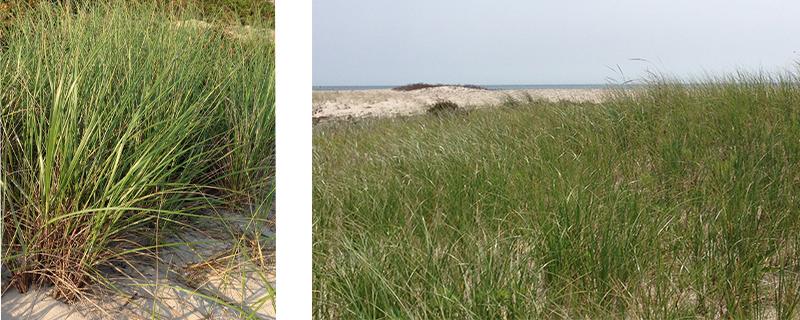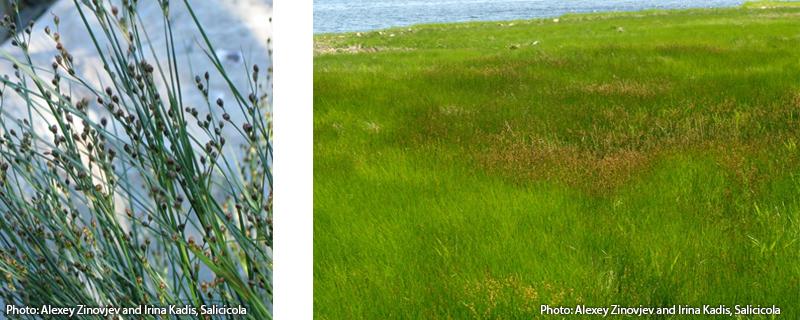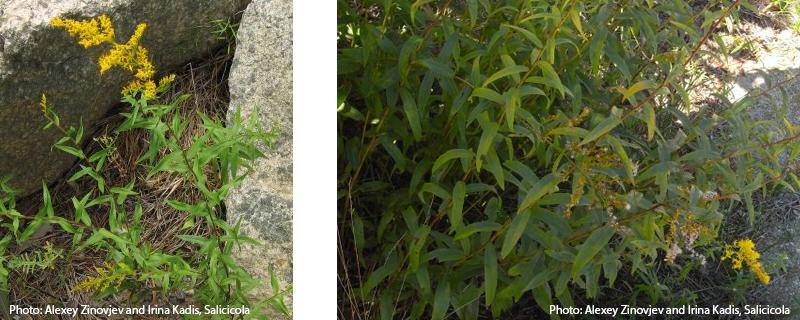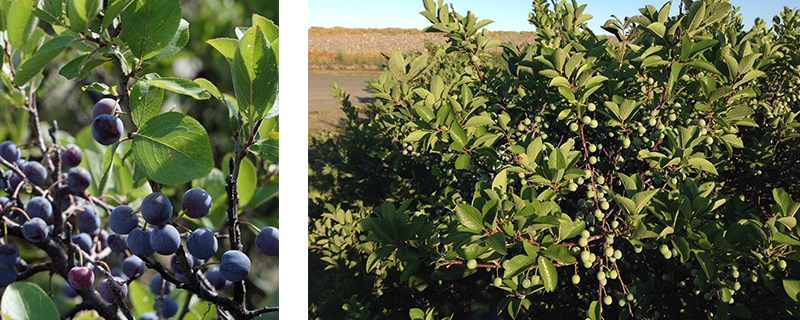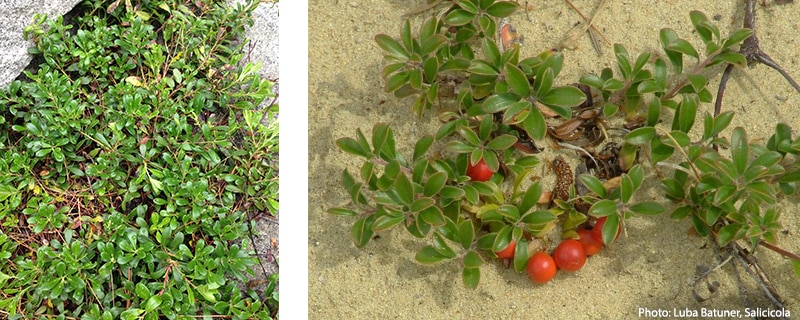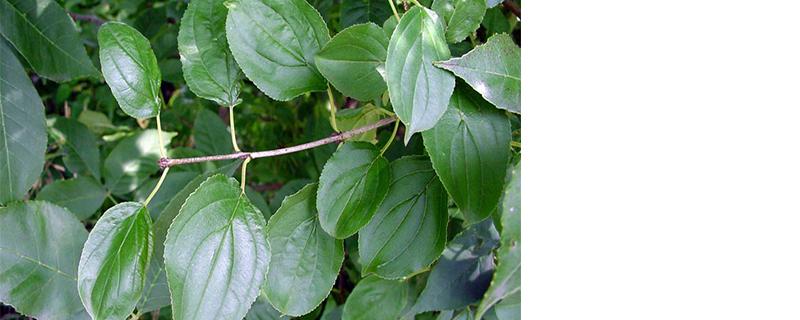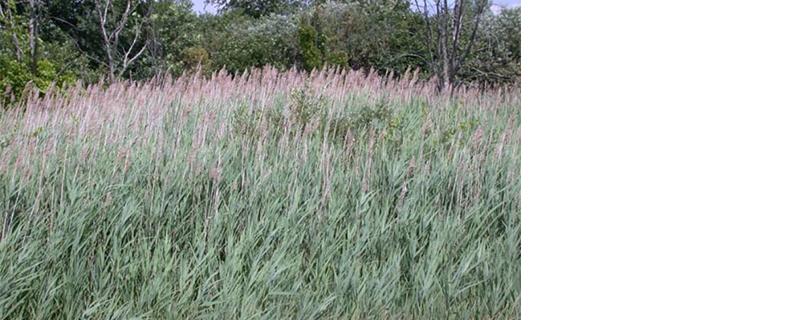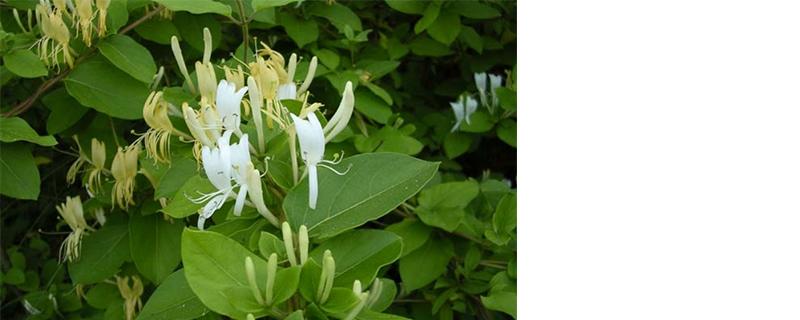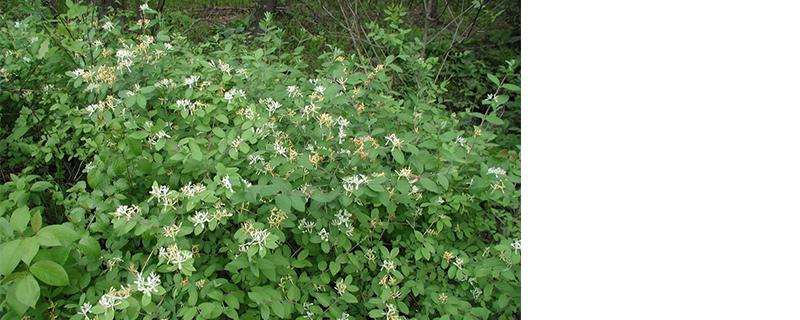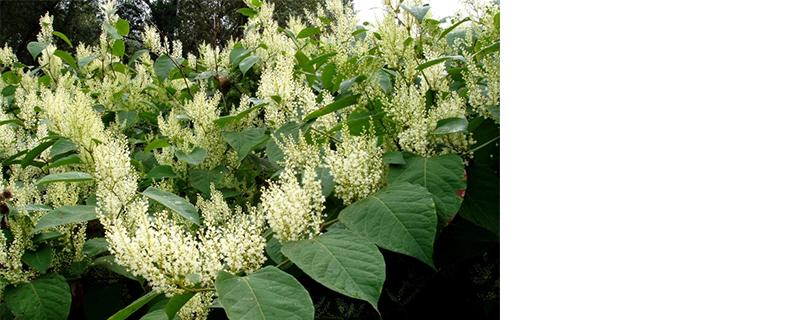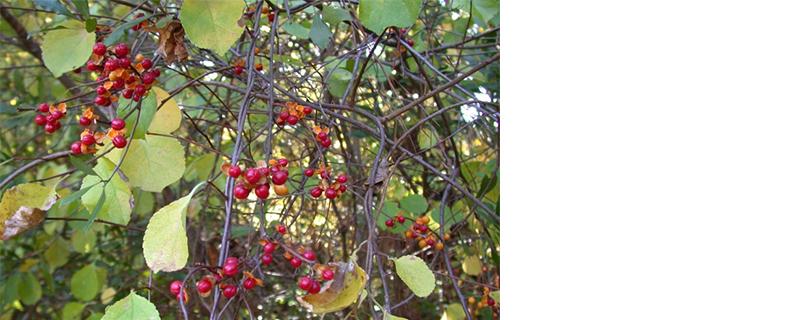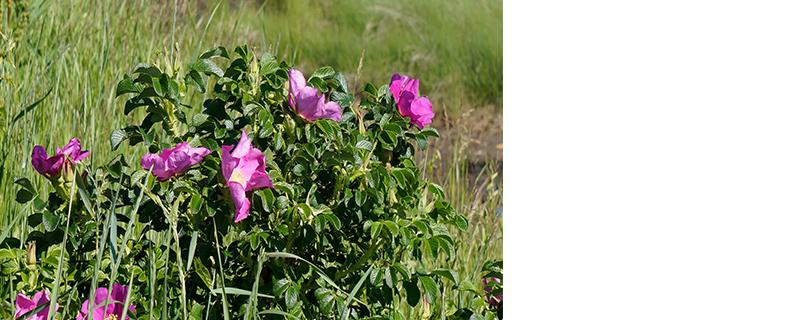Common Natives
Beachgrass (Ammophila breviligulata)
This leafy, perennial grass grows 2-3 feet tall and is typically found on beaches and dunes. To confirm its identity, look for long narrow leaves that are deeply furrowed on the upper surface and smooth on the underside (and sharp on the edges!). In late July or August, you will find spike-like seed heads emerging at the tips of long stalks. (Interesting tidbit: The upper leaf surface of beachgrass contains gas exchange openings, called stomata, which are oriented away from winds to conserve moisture; the leaves also roll at the edges to avoid exposure to the wind, intense heat, and excessive sunlight.) Beachgrass spreads vigorously every year by subsurface rhizomes (root-like underground stems).
Black Grass (Juncus gerardii)
Black grass is neither black nor a grass, but rather a green rush. Also known as salt marsh rush, this attractive plant has loose spikes or clusters of small, green-brown flowers emerging from rounded stems and grass-like leaves. Though this perennial herb appears delicate, it isn't—the stems and leaves of this species are actually quite sharp and it's a hardy contender in the coastal landscape because of its ability to spread by rhizomes and form extensive colonies in coastal estuaries and salt marshes. Look for it just above the high-tide line, where it is flooded only by the most extreme tides of each month. Having this affinity for water, you may also find black grass in rain gardens, stormwater basins, and low areas of the yard subject to flooding. (Interesting tidbit: Sedges have edges, rushes are round, grasses have joints from the tips to the ground.)
Little Bluestem (Schizachyrium scoparium)
This medium-height, densely tufted grass grows from 18 inches to 3 feet high, depending on the fertility of the soils. You can find little bluestem growing on a wide variety of soils and in areas subject to drought. The stems of little bluestem will appear blue in the spring and red in the fall and through winter. A good time to identify little bluestem is in the winter, when other grasses are matted down and the stems of little bluestem remain conspicuously upright. Winter is also a good time to observe the plentiful cotton-tufted seed heads. (Interesting tidbit: Little bluestem is one of the most widely distributed native grasses in North America.)
Sweet Goldenrod (Solidago odora)
Also known as anise-scented goldenrod, this clump-forming, perennial herb grows from 2 to 5 feet high with dark-green, lance-shaped leaves and large, bright yellow, terminal clusters of flowers that bloom in the late summer and continue into mid fall. To help confirm its identity, crush the leaves of sweet goldenrod and smell the licorice scent (these aromatic leaves can be used in teas and as an herbal remedy for many ailments). Look for bees and butterflies that are attracted to the sweet nectar and birds feeding on the seeds. (Interesting tidbit: Contrary to popular belief, it is ragweed—not goldenrod—that causes seasonal allergies.)
Beach Plum (Prunus maritima)
This iconic seaside plant is a 4- to 7-foot high, deciduous shrub found growing in extensive colonies in coastal areas of Massachusetts (beach plum can reach heights of 10 to 12 feet in inland, nutrient-rich soils). Beach plum is probably most notable for its fruit—the inch-sized reddish to purple beach plums, which ripen in late August to October, can be harvested and processed into jam, syrup, and puree. In the spring, look for small, snowy-white flowers emerging on the stems before the green leaves. (Interesting tidbit: Plum Island, Massachusetts, was named after the abundant beach plum plants that were found there.)
Bearberry (Arctostaphylos uva-ursi)
With its leathery, dark, evergreen leaves, small whitish-pink, urn-shaped flowers, bright red berries, and thick growing character, this low shrub/groundcover is easy to spot. Though bearberry generally grows 6 to 12 inches high and 3 to 6 feet wide, you may see bearberry covering a very large area of up to 15 feet wide. Look for the small flowers blooming from April to May and the bright red fruits appearing from August through the winter. (Interesting tidbit: Because the fruit was known to be a favorite food of bears, bearberry was given the name "uva-ursi," which in Latin translates to "bear's grape.")
Lowbush Blueberry (Vaccinium angustifolium)
This deciduous, twiggy shrub grows 6 inches to 2 feet tall and 2 feet wide. Look for small, dark-green leaves, which turn brilliant bronze or red in the fall—this plant often appears as a large swath of red when seen growing in meadows, on ledges, or in woodlands. The urn-shaped, white flowers can be seen blooming in May and the small, edible blueberries are ready for picking in mid-to-late-summer. (Interesting tidbit: Blueberries have one of the highest phytonutrient contents and antioxidant capacities among all fruits, vegetables, and spices—i.e., they fight off cancer and boost brain function.)
Northern Bayberry (Morella caroliniensis, previously Myrica pensylvanica)
Look for this woody shrub growing in thickets along the coast, usually in sandy soils. Bayberry grows from 5 to 7 feet high and has aromatic, dark-green leaves that often stay on the branches for most of the winter. The flowers (which are also aromatic) are somewhat inconspicuous, but the small fragrant berries are more easily identifiable by their blue-green-grey color and waxy coating. (Interesting tidbit: The wax from the bayberry fruit is used to make bayberry candles.)
Black Cherry (Prunus serotina)
This deciduous tree can grow 60 to 90 feet tall and 35 to 50 feet wide. In the spring, look for fragrant white flowers on pendulous stems and in the late summer, look for the purple-red, berry-like fruits. The bark from a young tree is easy to identify because of the presence of many light-colored lenticels (they look like little horizontal lines).You will find this tree succeeding quite well on the coast because it is very tolerant of salt and drought. (Interesting tidbit: The twig has a "bitter almond" smell and taste, though we don't recommend eating it—large amounts can cause cyanide poisoning!)
Invasive Non-Natives
Common Buckthorn (Rhamnus cathartica)
This shrub or small tree can grow up to 22 feet high and has bark and twigs that are often tipped with a spine. The oval, glossy leaves stay green late into the fall, after most other deciduous leaves have fallen. In spring, look for dense clusters of 2 to 6 yellow-green flowers; the small black fruit are produced throughout the growing season. Common buckthorn is problematic because it forms dense thickets and crowds and shades out native plants. The density of seedlings covering the ground can also prevent natives from regenerating. (Interesting tidbit: Common buckthorn fruit that is eaten by birds and mice produces a severe laxative effect, helping distribute the seeds far and wide.)
Common Reed (Phragmites australis subsp. australis)
This tall, perennial grass has long, wide, and flat leaves and grayish purple, dense, and silky plume-like flower heads, which appear from July to October. In the fall, the plant turns brown and the flower heads persist throughout the winter. Common reed is usually found growing in or near shallow, brackish water in tall (as high as 15 feet) impenetrable thickets. It has proven to be an aggressive wetland invader that displaces native wetland plants, alters the hydrology, and blocks sunlight to the aquatic community. In addition, the rhizomes can extend down over 6 feet to reach ground water and can grow horizontally to form dense mats that deter other plants from becoming established. (Interesting tidbit: The flowering plumes can be used in upholstery and the stalks or leaves can be used for thatching, sandals, baskets, brooms, and mats.)
Japanese Honeysuckle (Lonicera japonica)
This rapidly growing, woody, perennial vine can be found either trailing or climbing to lengths of 80 feet or more. Look for 1- to 2½-inch oval leaves and showy, fragrant, tubular, yellow-whitish-pink flowers blooming from April to July. The small, shiny fruits contain 2-3 small seeds each, and these are rapidly dispersed by birds. This non-native honeysuckle can also spread by underground rhizomes and above ground runners and can form dense stands that overwhelm native vegetation—this vine can girdle small saplings and shade out undergrowth. (Interesting tidbit: The flower is highly valued in traditional Chinese medicine and used to treat "heat conditions," such as fevers, skin rashes, and sore throat.)
Morrow's Honeysuckle (Lonicera morrowii)
This honeysuckle is a multi-stemmed, upright, deciduous shrub and a hybrid of nonnative honeysuckles. In the spring, look for the grayish-green, rounded leaves that emerge before most other plants leaf out and the fragrant, tubular, creamy-white flowers that develop in pairs. From these paired flowers emerge reddish-orange fruits that often persist throughout winter. Through the help of birds and mammals dispersing the seeds, this plant has invaded open woodlands, old fields, and other disturbed sites—forming dense understory thickets that prevent native plants from growing. (Interesting tidbit: The invasive bush honeysuckles all have hollow stems, while the stems of the native honeysuckles are solid.)
Japanese Knotweed (Polygonum cuspidatum or Fallopia japonica)
You can easily find this perennial, herbaceous, dense-growing shrub near water sources or in low-lying areas, utility rights-of-way, and other disturbed sites. The semi-woody, reddish-brown stems are hollow with enlarged nodes (where the leaf meets the stem). Look for big, 6-inch by 4-inch oval leaves that are pointed at the tip and small, greenish-white flowers in long panicles that appear in late summer. Japanese knotweed spreads quickly by both underground rhizomes and seeds and forms extremely dense, tall thickets up to 10 feet high that exclude native vegetation. Once established, this plant is extremely hard to eradicate. (Interesting tidbit: Japanese knotweed is edible and nutritious—it is currently being used as forage for many of the herbivores at Franklin Park Zoo; the giraffes love it.)
Oriental Bittersweet (Celastrus orbiculatus)
Also known as Asiatic bittersweet, this perennial, deciduous, climbing, woody vine can grow to lengths of 60 feet. The flowers are inconspicuous, but the small fruits can be more readily identified by their changing colors: green when young, ripening to yellow, then splitting to reveal bright scarlet berries that persist into winter. Through berry and seed dispersal by both birds and humans, this vine has invaded forest edges, woodlands, fields, coastal areas, and salt marsh edges. It can wrap itself around, smother, shade, and kill native vegetation. (Interesting tidbit: To differentiate Oriental bittersweet from its look-alike, American bittersweet (Celastrus scandens), note the location of the flowers and fruits: those of Oriental bittersweet appear where the leaves meet the stems, while those of the native variety bloom at the ends of the branches.)
Non-Native and Potentially Invasive
Rugosa Rose (Rosa rugosa)
This common seaside shrub is native to eastern Asia and potentially invasive in some regions or habitats of Massachusetts. Rugosa rose is often planted on coastal sites because it is extremely tolerant of sea spray and storms, making it well adapted to the coastal environment. On dune sites, the shrub is useful for erosion control and stabilization and because of its thorny stems can also be strategically planted to direct pedestrians away from or between sand dunes. However, because of its ability to spread by seeds and by rhizomes, it has an ability to outcompete and displace other native beach and dune plants. In addition, on bank sites, rugosa rose is less effective at controlling erosion and may in fact worsen the problem when other more effective erosion control plants are unable to grow due to shading effects.
Additional Information
The following links provide additional information on native and non-native invasive plants:
- Coastal Landscaping - This Massachusetts Office of Coastal Zone Management (CZM) website provides information on the benefits of landscaping coastal property with native, hardy, salt-tolerant plant species and includes plant lists, sample landscape plans, photographs, and detailed plant information.
- American Beauties Native Plants - From the National Wildlife Federation, this website offers information and identifying features of native plants, including trees, shrubs, vines, grasses, and wildflowers.
- Go Botany - This website of the Native Plant Trust provides plant identification keys (both simple and advanced) to help identify over 3,000 common native and naturalized New England plants.
- Lady Bird Johnson Wildflower Center Plant Database - This comprehensive website includes a search engine that links to and describes 7,220 native plants in North America, an image gallery, and recommended species for specific regions.
- PLANTS Database - This database by the U.S. Department of Agriculture (USDA) Natural Resources Conservation Service (NRCS) provides plant descriptions, characteristics and classification, distribution, and images.
- The Vascular Plants of Massachusetts: A County Checklist - This publication, available on CD through the Natural Heritage and Endangered Species Program, lists the specific native status and distribution of the plants found in the various counties of Massachusetts.
- CZM's Marine Invasive Species Program - This website provides information to promote understanding, effective monitoring, and management of marine invasive species.
- The Evaluation of Non-Native Plant Species (PDF, 273 KB) - This online publication by the Massachusetts Invasive Plant Group (MIPAG) is a master list of non-native plant species and their potential for invasiveness in Massachusetts.
- Invasive Species - This Mass Audubon web page provides users with information on invasive plant species and what can be done about them.
- Native Plant Trust's Controlling Invasives - Information on invasive plants, a photo gallery of invasive plants, guidelines for controlling them, links to invasive species removal projects, and links to other invasive plant information are available on this Native Plant Trust website.
- Invasive Plant Atlas of New England - This comprehensive database provides a list of plants considered to be invasive or potentially invasive in New England.
- Invasive Plant Atlas of the United States - This website is a compilation of information from many sources—including federal, state, and local government agencies, invasive species councils, and other experts and organizations—about non-native plant species, including detailed descriptions and photographs.
Photo credits
Native Plants - Unless otherwise noted, photographs are courtesy of the Massachusetts Office of Coastal Zone Management (CZM). Noted sources:
- Dr. Mark H. Brand. 2018. University of Connecticut Plant Database of Trees, Shrubs, and Vines. Department of Plant Science, University of Connecticut, Storrs, CT.
- Salicicola. 2018. Eastern Massachusetts Vascular Plant Gallery.
Invasive Plants - All photos courtesy of Bugwood.org with specific acknowledgements: Common Buckthorn: Chris Evans, University of Illinois; Common Reed and Morrow's Honeysuckle: Leslie J. Mehrhoff, University of Connecticut; Japanese Honeysuckle: Chuck Bargeron, University of Georgia; Japanese Knotweed: Jan Samanek, State Phytosanitary Administration; Oriental Bittersweet: James R. Allison, Georgia Department of Natural Resources.
Potentially Invasive - Rugosa Rose: CZM.
